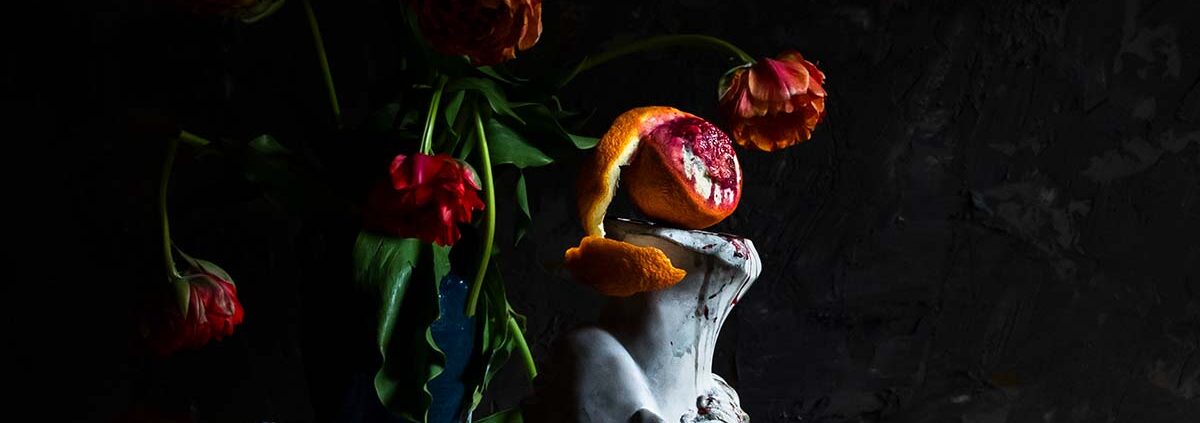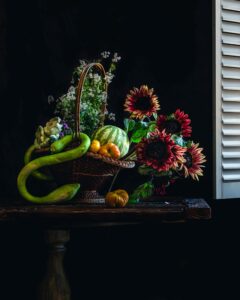let it shine: Photographs by Mina Afshari
/in Past Exhibitions /by Elizabeth MooreJune 24, 2023 - October 29, 2023
Lightcatcher Building
The Museum is pleased to showcase California-based artist Mina Afshari’s photographs for her first museum exhibit. Afshari is a young Iranian woman who longed for freedom not only from the oppressive regime of Iran but also from prolonged family trauma. After arriving in the United States and experiencing the wind of freedom in her hair, she has found beauty and healing in allowing herself to open up to the expansiveness of her new home. The photographs in Let it Shine were created in her Carmel, California apartment, using a single light source—a window—to illuminate farmer’s market produce and flowers. She captures the beauty of the contrast between darkness and luminous light. This exhibit is the story of losing oneself in the dark edge of life but being given another chance to be alive in the most colorful way.
About Mina Afshari
Growing up in Iran, Mina Afshari witnessed even the most basic human rights being denied. She had to fight for her safety against the government, as well as at home, where she experienced physical and emotional abuse. These experiences awoke her to the world at an early age. Now, she’s fighting to reclaim her innocence.
When Afshari was five years old, and her brother was two, they were kidnapped for four months, where she witnessed him being abused. Feeling helpless, her response as a five-year-old was to fight by dumping food on the carpet or throwing clothespins off the balcony.
Throughout her childhood, Afshari was faced with hardships, such as providing emotional support for her father, enduring anger from her mother, caregiving her mother through terminal cancer, experiencing deception and manipulation from extended family, and the death of her brother. From a very young age, she promised herself never to feel again and, through the years, detached and numbed out her emotions as she learned to people please to find safety.
As a teenager, Afshari was compelled to find a corner of freedom for herself, rebelling against the enforcement of Iran’s rules over women’s clothing and head coverings. She cut her hair short, wore boy clothes, and rode her bicycle at night to feel freedom and the wind in her hair. Eventually, she was arrested at gunpoint by Iran’s “morality police.” When they insisted that her family had to bring proper clothing to release her, she defied them, stating that she had no family and no other clothes. Eventually, to her surprise, they released her. She raised her hand for a cab feeling victorious as she walked out wearing the same “inappropriate” clothing she was arrested in.
It was after coming to the United States during her mother’s cancer treatment and grieving the loss of her mother that Afshari entered a gym for the first time and began her slow journey of healing. Through the years, her childhood traumas manifested in illness and hopelessness. She learned that her traumas were at the root of her illness and began to get help through meditation, exercise, and education.
The pandemic gave Afshari a new opportunity to shift her focus. During the shelter-in-place orders, she started taking photographs of produce from the local farmer’s market to promote their services on social media. She became obsessed with capturing the produce in the most flattering way, using light from a single window in her apartment and exploring the contrasts of darkness and luminous light. Picking up the camera was very healing for Afshari, who felt grounded and at peace. She says, “Experimenting with still life photos, I feel I’m reclaiming my innocence again.”
Afshari, currently a university student pursuing a degree in economics, has taken on the role of a research apprentice in the realm of behavioral economics. Guided by her mentors, she employs quantitative methods to explore the intricate interplay between personal history and individual decision-making. Afshari is especially interested in investigating the lives of founders and CEOs as she can personally relate to the resilience and unrelenting resourcefulness of the individuals she studies. Her burning question is to answer what causes us to become compassionate towards each other and what transforms self-preservation into compassion.
This presentation of Afshari’s photographs is her first exhibit at a museum. Afshari’s work is a direct reflection of journeying through trauma and communicates the innocence that exists within each of us regardless of the darkness through which we’ve traveled. She believes that there is immense power within each individual, even when feeling completely helpless and hopeless. Through her work and her story, she hopes that others find their own strength to take positive, empowering actions to gain back what seemed to have been lost.
The Whatcom Museum acknowledges that we gather on the traditional territory of the Lhaq’temish – Lummi People – and the Nuxwsá7aq – Nooksack People – who have lived in the Coast Salish region from time immemorial. The Museum honors our relationship with all of our Coast Salish neighbors and our shared responsibilities to their homeland where we all reside today.






